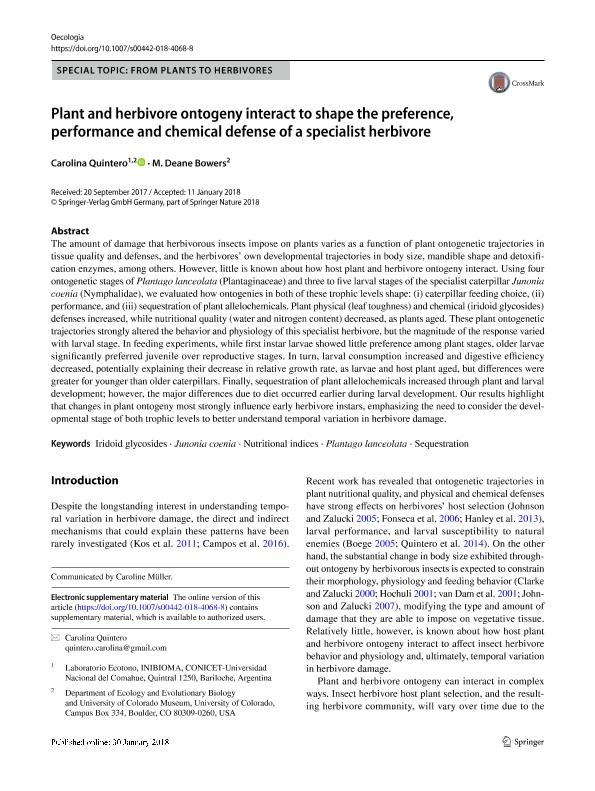Mostrar el registro sencillo del ítem
dc.contributor.author
Quintero, Carolina

dc.contributor.author
Bowers, M. Deane
dc.date.available
2020-01-02T22:13:45Z
dc.date.issued
2018-06-30
dc.identifier.citation
Quintero, Carolina; Bowers, M. Deane; Plant and herbivore ontogeny interact to shape the preference, performance and chemical defense of a specialist herbivore; Springer; Oecologia; 187; 2; 30-6-2018; 401-412
dc.identifier.issn
0029-8549
dc.identifier.uri
http://hdl.handle.net/11336/93332
dc.description.abstract
The amount of damage that herbivorous insects impose on plants varies as a function of plant ontogenetic trajectories in tissue quality and defenses, and the herbivores’ own developmental trajectories in body size, mandible shape and detoxification enzymes, among others. However, little is known about how host plant and herbivore ontogeny interact. Using four ontogenetic stages of Plantago lanceolata (Plantaginaceae) and three to five larval stages of the specialist caterpillar Junonia coenia (Nymphalidae), we evaluated how ontogenies in both of these trophic levels shape: (i) caterpillar feeding choice, (ii) performance, and (iii) sequestration of plant allelochemicals. Plant physical (leaf toughness) and chemical (iridoid glycosides) defenses increased, while nutritional quality (water and nitrogen content) decreased, as plants aged. These plant ontogenetic trajectories strongly altered the behavior and physiology of this specialist herbivore, but the magnitude of the response varied with larval stage. In feeding experiments, while first instar larvae showed little preference among plant stages, older larvae significantly preferred juvenile over reproductive stages. In turn, larval consumption increased and digestive efficiency decreased, potentially explaining their decrease in relative growth rate, as larvae and host plant aged, but differences were greater for younger than older caterpillars. Finally, sequestration of plant allelochemicals increased through plant and larval development; however, the major differences due to diet occurred earlier during larval development. Our results highlight that changes in plant ontogeny most strongly influence early herbivore instars, emphasizing the need to consider the developmental stage of both trophic levels to better understand temporal variation in herbivore damage.
dc.format
application/pdf
dc.language.iso
eng
dc.publisher
Springer

dc.rights
info:eu-repo/semantics/openAccess
dc.rights.uri
https://creativecommons.org/licenses/by-nc-sa/2.5/ar/
dc.subject
IRIDOID GLYCOSIDES
dc.subject
JUNONIA COENIA
dc.subject
NUTRITIONAL INDICES
dc.subject
PLANTAGO LANCEOLATA
dc.subject
SEQUESTRATION
dc.subject.classification
Ecología

dc.subject.classification
Ciencias Biológicas

dc.subject.classification
CIENCIAS NATURALES Y EXACTAS

dc.title
Plant and herbivore ontogeny interact to shape the preference, performance and chemical defense of a specialist herbivore
dc.type
info:eu-repo/semantics/article
dc.type
info:ar-repo/semantics/artículo
dc.type
info:eu-repo/semantics/publishedVersion
dc.date.updated
2019-10-10T13:47:18Z
dc.journal.volume
187
dc.journal.number
2
dc.journal.pagination
401-412
dc.journal.pais
Alemania

dc.journal.ciudad
Berlín
dc.description.fil
Fil: Quintero, Carolina. Consejo Nacional de Investigaciones Científicas y Técnicas. Centro Científico Tecnológico Conicet - Patagonia Norte. Instituto de Investigaciones en Biodiversidad y Medioambiente. Universidad Nacional del Comahue. Centro Regional Universidad Bariloche. Instituto de Investigaciones en Biodiversidad y Medioambiente; Argentina. Universidad Nacional del Comahue. Centro Regional Universitario Bariloche. Laboratorio de Ecotono; Argentina. State University of Colorado at Boulder; Estados Unidos
dc.description.fil
Fil: Bowers, M. Deane. State University of Colorado at Boulder; Estados Unidos
dc.journal.title
Oecologia

dc.relation.alternativeid
info:eu-repo/semantics/altIdentifier/url/https://link.springer.com/article/10.1007%2Fs00442-018-4068-8
dc.relation.alternativeid
info:eu-repo/semantics/altIdentifier/doi/http://dx.doi.org/10.1007/s00442-018-4068-8
Archivos asociados
